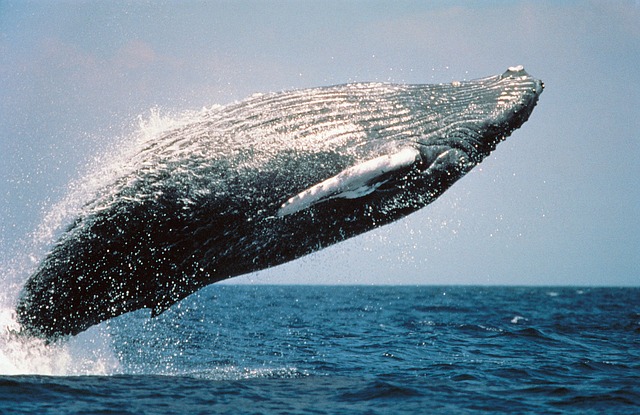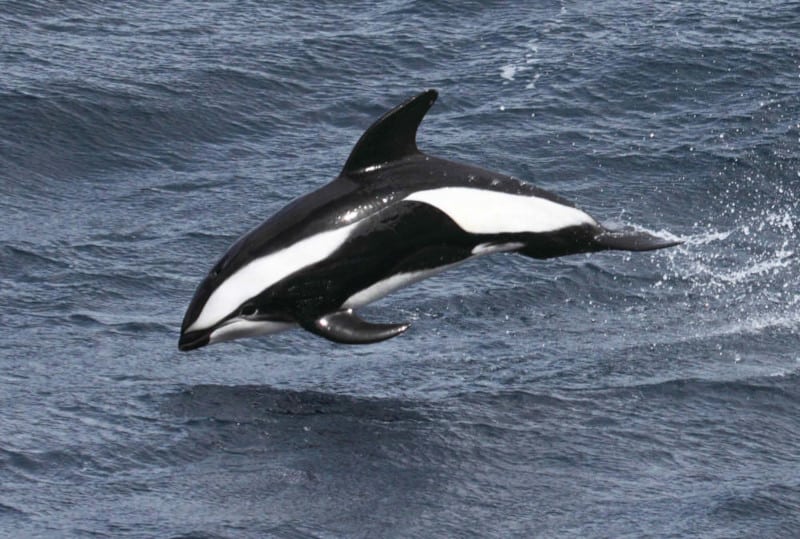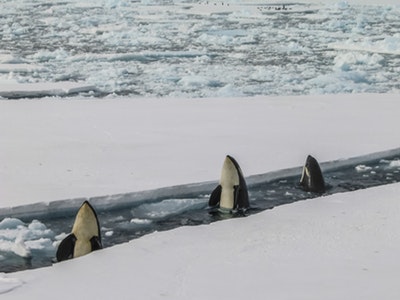
Antarctica is a prime area for whales and a whale is considered to be an Antarctic whale if it spends at least part of the year in Antarctic waters. There are at least 15 whales that fulfil this criteria but the most common whales you are likely to see in Antarctic waters are the Blue Whale, Fin, Humpback, Minke, Right, Sei, Sperm whales and Killer Whales (Orcas). Orcas are actually dolphins but because of their large size are often referred to as whales
Whales are the largest living animals today and despite decades of hunting, whale numbers have recovered in many cases.
As for Dolphins, The hourglass dolphin is the only small dolphin species found in Antarctic waters.

Blue whales
Starting with the largest and longest living, we have the Blue whale. Unfortunately, they were decimated by whale hunting last century and are still recovering, so they are not as commonly seen as other whales. With a length of 30 metres or so and a lifespan of 80-100 years or more, they are an impressive animal. Often seen on the edge of the Antarctic see ice they feed mainly on krill and can consume up to 4 tonnes every day.
Fin whales
The second largest of the whales is the Fin whale. Like other baleen whales, fin whales open their mouths to take in large amounts of water and then they close their mouths and expel the water through their baleens (sort of like a strainer) and trap their prey. They can be identified by the pronounced ridge behind their dorsal fin (top fin). They spend much of their time in the deep ocean so have been hard to study.
Sperm whales
The sperm whale has a large, square head that makes up a third of its body and has wrinkly skin. Since they are toothed whales they catch fish and squid in their preferred waters, usually more than 200 metres deep. They can dive to more than 1000 metres and can stay under for over an hour, though on most dives they usually only stay for half this time.
Sei whales
Sei whales are the most northern Antarctic baleen whale, often found north of 60° latitude in summer. They are distinguished by a uniform colouring and swirling marks on their skin. Unlike other baleen whales of their family (the Rorqual) who feed on krill, the Sei whales feed on small or microscopic aquatic crustaceans called copepods, collecting them by swimming through the water with their mouths wide open.
Minke whales
In the middle of winter you’ll find Minke whales in Antarctic waters, even in areas of heavy pack ice where they stick their heads up through cracks to breathe. In the summer they prefer areas of open pack ice, which is lots of patches of ice surrounded by water. They feed mainly on krill by gulping it as they swim. If there is a lot of krill they can sometimes be seen numbering in the hundreds while feeding.
Humpback whales
Recognised by the distinctive hump in front of its small dorsal fin the humpback whale is very active and is often the one you will see leaping out of the water (breaching). They are famous for their songs which are usually less than ten minutes long but are repeated sometimes for hours. Their tails have a unique black and white pattern, enabling individuals to be identified. They can travel up to 10,000 km each year while travelling between the summer feeding grounds in the Antarctic to their breeding/calving grounds in the tropics. They eat krill and small fish and are another member of the baleen whales.
Right whales
Right whales are a type of baleen whale which lives on krill and smaller crustaceans called copepods. They are almost as massive, weight wise, as a blue whale though they only grow to 18-19 metres in length. Though their name is supposedly derived from whalers considering them to be the ‘right’ whale to hunt, there is no real proof. Bascially, no-one is sure where the name came from. They are identified by the distinctive rough patches of skin on its head (callosities)and no dorsal fin.
Killer whales
Killer whales (orcas) are the largest member of the oceanic dolphin family of toothed whales. They have a diverse diet, from fish to seals to dolphins and even other whales. As an apex predator there is no animal higher in the food chain that eats them. They are distinguished by a high dorsal fin and a white patch above and behind the eye. Although historically viewed as dangerous there is no known instance of a wild killer whale harming a human.

